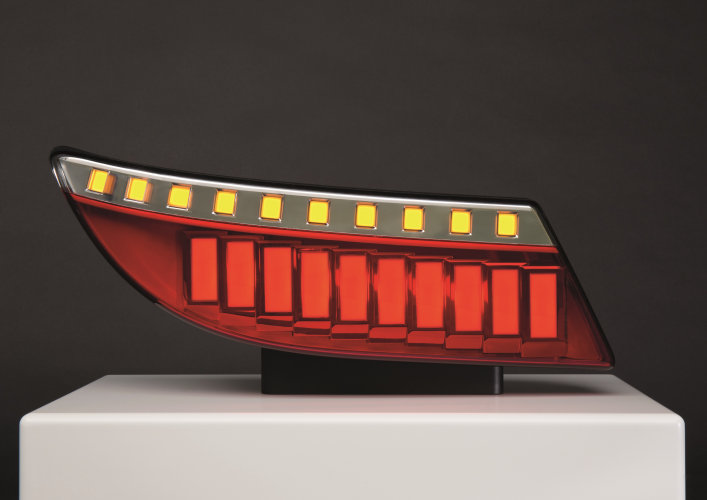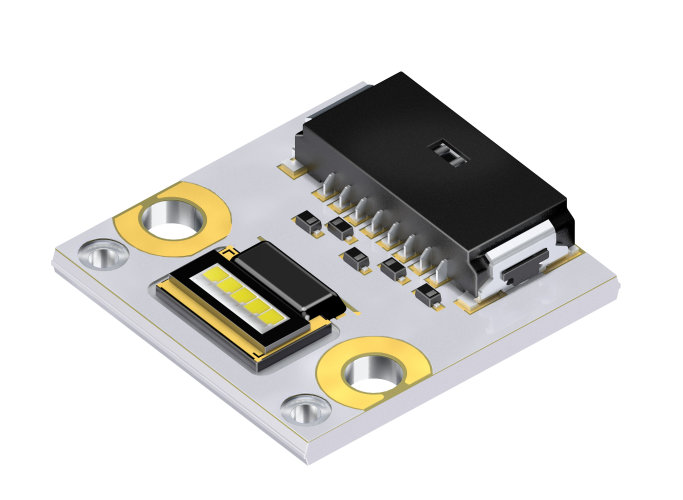Osram presents future technologies for car headlights

Osram showed its new products for the coming generation of car headlights at the tenth International Symposium on Automotive Lighting (ISAL) in Darmstadt, Germany (24 to 25 September 2013). A road-compliant OLED tail light, LED products for glare-free high beam light and a survey from the laser light sector could be experienced among other interesting topics.
OLED tail light: Market maturity on the horizon
This past year, Osram displayed an OLED demonstrator (OLED = organic light emitting diode) at the electronica fair. The company presented its successor at the ISAL, which now complies with the requirements for road traffic as defined internationally in the Economic Commission for Europe (ECE) standards, and not only for rear light but also for braking light. In addition, the homogeneous luminous surface can be split into dynamically controllable segments to allow special lighting sequences to be played with a click on the remote control for the door lock. The new OLED tail light means that OSRAM has largely achieved road compatibility this year. It is expected that organic light emitting diodes will be seen as series products on roads from 2016 onwards.
MatrixLED: A more intelligent headlight
Advanced Forward Lighting Systems (AFS in short), meaning the light of headlights that follows the course of the road, is being implemented by ever more premium vehicles. Thanks to LED technology, this functionality as well as new functions such as glare-free high beam light or marking light can be implemented more simply than before because the mechanical control for movement of the headlight is mainly no longer needed. Osram offers light sources ranging from single LEDs to complete modules to enable automotive producers to produce AFS systems more simply. With a new variant of the Ostar Headlamp Pro, Osram has for the first time specifically developed an LED component for AFS applications. The five chips of the new multichip LED can be individually controlled and thus flexibly switched on and off according to the driving situations and positions of other road users. The company also displayed a module for the so-called matrix headlight. Each individual LED in the module can be separately controlled and dimmed, and oncoming vehicles are precisely removed from the light distribution thanks to sensors and special electronics. In combination with a camera system, the module identifies obstacles on the roadside and illuminates these.
A design study for a laser headlight: The next step for automotive light
Laser light is the next major development step in automotive lighting. The advantage of the technology is the extremely focused light that can be directed with high precision. The light emitting surface is also very small, which means that the headlights can be designed to be more compact than today's models. Osram showed a demonstrator at ISAL to highlight future design options for headlights with laser light sources. The laser light source from Osram is based on a combination of laser and phosphor: The rays of several blue laser diodes are focused on to a phosphor conversion module that converts these into white light. This light is then coupled into the optical system of the headlight as with classic car light technology, and directed onto the surface of the road. Osram supplies similar systems under the name of "Phaser" for applications such as projectors and endoscopy equipment. The name of Phaser is taken from the combination of phosphor and laser.
Xenon light: A 35 watt lamp with a new control gear generation
OSRAM also showed a derivative of its 35 watt xenon system on basis of its mercury-free D3 xenon lamp. The twin-level ballast for cars, buses and trucks now contains a boost function that improves high beam light. The function ensures that the luminous flux of 3,200 lumens with low beam (35W) increases to 3,650 lumens with high beam (38W). This means better visibility along with increased safety for drivers. The high level of luminous flux remains constant over a period of several thousand hours.
Halogen light: Well-combined with LED
For low-budget LED headlights, automotive producers often depend on a combination with classic technology. Osram has developed a concept for halogen lamps that can be assembled into LED headlights for high beam light. The lamp has a high color temperature of at least 4,500 Kelvin, and with regard to color is thus suitable for daylight-similar LED light. The lamp base is also similar to an H7 base, meaning that existing reflector designs can be adopted with ease, and effort for integration remains low.
Image gallery



ABOUT OSRAM
OSRAM of Munich, Germany is one of the two leading light manufacturers in the world. The company's portfolio covers the entire value chain from components – including lamps, opto semiconductors like light-emitting diodes (LED) – to electronic control gears as well as complete luminaires, light management systems and lighting solutions. OSRAM has around 39,000 employees worldwide and generated revenue of 5.4 billion Euros in fiscal year 2012 (ended September 30, 2012). More than 70 percent of its revenue comes from energy-efficient products. The company's business activities have been focusing on light – and hence on quality of life – for over 100 years. Additional information can be found in the internet at www.osram-group.com